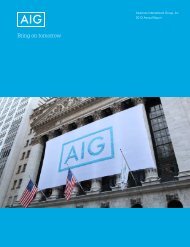2007 Annual Report - AIG.com
2007 Annual Report - AIG.com
2007 Annual Report - AIG.com
You also want an ePaper? Increase the reach of your titles
YUMPU automatically turns print PDFs into web optimized ePapers that Google loves.
American International Group, Inc. and Subsidiaries<br />
8. Derivatives and Hedge Accounting<br />
Continued<br />
The following table presents the notional amounts by remaining maturity of Capital Markets’ interest rate, credit<br />
default and currency swaps and swaptions derivatives portfolio at December 31, <strong>2007</strong> and 2006:<br />
Remaining Life of Notional Amount*<br />
One Two Through Six Through After Ten Total Total<br />
(in millions) Year Five Years Ten Years Years <strong>2007</strong> 2006<br />
Interest rate swaps $441,801 $ 554,917 $156,634 $14,112 $1,167,464 $1,058,279<br />
Credit default swaps 184,924 286,069 85,792 5,028 561,813 483,648<br />
Currency swaps 38,384 135,187 41,675 9,029 224,275 218,091<br />
Swaptions, equity and <strong>com</strong>modity swaps 57,709 62,849 35,270 23,139 178,967 180,040<br />
Total $722,818 $1,039,022 $319,371 $51,308 $2,132,519 $1,940,058<br />
* Notional amount is not representative of either market risk or credit risk and is not recorded in the consolidated balance sheet.<br />
receives an option premium and then manages the risk of any<br />
unfavorable change in the value of the underlying <strong>com</strong>modity,<br />
currency or index by entering into offsetting transactions with<br />
third-party market participants. Risks arise as a result of<br />
movements in current market prices from contracted prices, and<br />
the potential inability of the counterparties to meet their obliga-<br />
tions under the contracts.<br />
Futures and forward contracts are contracts that obligate the<br />
holder to sell or purchase foreign currencies, <strong>com</strong>modities or<br />
financial indices in which the seller/purchaser agrees to<br />
make/take delivery at a specified future date of a specified<br />
instrument, at a specified price or yield. Options are contracts that<br />
allow the holder of the option to purchase or sell the underlying<br />
<strong>com</strong>modity, currency or index at a specified price and within, or at,<br />
a specified period of time. As a writer of options, <strong>AIG</strong>FP generally<br />
The following table presents Capital Markets futures, forward and option contracts portfolio by maturity and type of<br />
derivative at December 31, <strong>2007</strong> and 2006:<br />
Remaining Life<br />
One Two Through Six Through After Ten Total Total<br />
(in millions) Year Five Years Ten Years Years <strong>2007</strong> 2006<br />
Exchange traded futures and options contracts<br />
contractual amount $ 27,588 $1,359 $ — $ — $ 28,947 $ 27,271<br />
Over the counter forward contracts contractual<br />
amount 485,332 5,864 1,850 — 493,046 492,913<br />
Total $512,920 $7,223 $1,850 $ — $521,993 $520,184<br />
<strong>AIG</strong>FP Credit Default Swaps<br />
<strong>AIG</strong>FP enters into credit derivative transactions in the ordinary<br />
course of its business. The majority of <strong>AIG</strong>FP’s credit derivatives<br />
require <strong>AIG</strong>FP to provide credit protection on a designated<br />
portfolio of loans or debt securities. <strong>AIG</strong>FP provides such credit<br />
protection on a ‘‘second loss’’ basis, under which <strong>AIG</strong>FP’s<br />
payment obligations arise only after credit losses in the desig-<br />
nated portfolio exceed a specified threshold amount or level of<br />
‘‘first losses.’’ The threshold amount of credit losses that must<br />
be realized before <strong>AIG</strong>FP has any payment obligation is negotiated<br />
by <strong>AIG</strong>FP for each transaction to provide that the likelihood of any<br />
payment obligation by <strong>AIG</strong>FP under each transaction is remote.<br />
The underwriting process for these derivatives included assump-<br />
tions of severely stressed recessionary market scenarios to<br />
minimize the likelihood of realized losses under these obligations.<br />
In certain cases, the credit risk associated with a designated<br />
portfolio is tranched into different layers of risk, which are then<br />
analyzed and rated by the credit rating agencies. Typically, there<br />
will be an equity layer covering the first credit losses in respect of<br />
the portfolio up to a specified percentage of the total portfolio,<br />
and then successive layers ranging from generally a BBB-rated<br />
layer to one or more AAA-rated layers. In transactions that are<br />
rated with respect to the risk layer or tranche that is immediately<br />
junior to the threshold level above which <strong>AIG</strong>FP’s payment<br />
obligation would generally arise, a significant majority are rated<br />
AAA by the rating agencies. In transactions that are not rated,<br />
<strong>AIG</strong>FP applies the same risk criteria for setting the threshold level<br />
for its payment obligations. Therefore, the risk layer assumed by<br />
<strong>AIG</strong>FP with respect to the designated portfolio in these transac-<br />
tions is often called the ‘‘super senior’’ risk layer, defined as the<br />
layer of credit risk senior to a risk layer that has been rated AAA<br />
by the credit rating agencies, or if the transaction is not rated,<br />
equivalent thereto.<br />
<strong>AIG</strong> <strong>2007</strong> Form 10-K 163

















